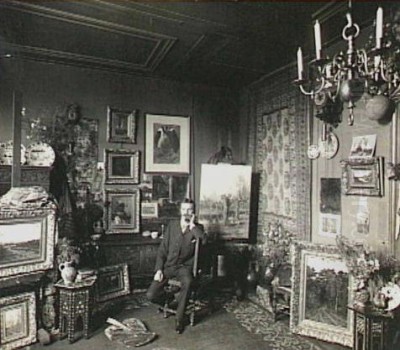
Arnold Marc Gorter stands as a significant figure in Dutch art history, celebrated primarily for his evocative landscape paintings. Active during a period of transition, from the late nineteenth century into the early twentieth century, Gorter captured the serene beauty of the Dutch countryside with a distinctive blend of influences, bridging the traditions of the Hague School and Barbizon painters with a personal, impressionistic sensibility. His dedication to depicting nature, particularly the woods, rivers, and pastoral scenes of his homeland, earned him both national and international acclaim.
Early Life and Artistic Formation
Born in 1866 in Almelo, a rural area in the Twente region of the eastern Netherlands, Arnold Marc Gorter's affinity for nature was cultivated from a young age. His upbringing in the countryside provided endless inspiration for his later work. Significantly, his mother, Geertruida ten Holtmeijer, was herself an artist, specializing in flower painting. Being the youngest of eleven children, Gorter likely benefited from this artistic environment, which fostered his innate interest in both the natural world and the practice of art. This early exposure undoubtedly laid the groundwork for his future career.
Seeking formal training, Gorter moved to Amsterdam in 1884. He enrolled in the prestigious Rijksacademie van Beeldende Kunsten (National Academy of Fine Arts), where he studied from 1888 to 1890. During his time at the academy, he honed his technical skills and deepened his understanding of art history and contemporary movements. He successfully obtained the Middelbare Akte (Secondary Certificate) for drawing, signifying a solid foundation in the academic principles of art, which he would later adapt to his more personal, atmospheric style.
Artistic Style and Influences
Gorter's artistic style is most accurately characterized as a form of late Dutch Impressionism, deeply rooted in the landscape tradition. While he studied academic principles, his true passion lay in capturing the mood and light of the natural world en plein air or based on outdoor studies. His work shows a clear affinity with the French Barbizon School, painters like Jean-Baptiste-Camille Corot, Charles-François Daubigny, Jean-François Millet, and Théodore Rousseau, who emphasized realistic depictions of rural life and landscape, often imbued with a romantic or poetic sensibility.
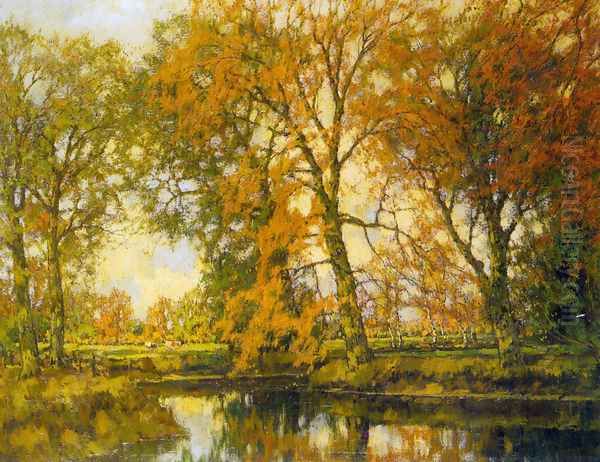
Furthermore, Gorter's work resonates strongly with the preceding generation of Dutch painters known as the Hague School. Artists such as Jacob Maris, Willem Maris, Anton Mauve, Jozef Israëls, Johannes Bosboom, and Hendrik Willem Mesdag had already established a Dutch tradition of atmospheric landscape painting, focusing on light, tonal harmony, and everyday rural scenes. Gorter continued this tradition but infused it with brighter colours and sometimes looser brushwork, reflecting the broader influence of Impressionism, though perhaps less radically than French contemporaries like Claude Monet or Camille Pissarro.
His paintings typically feature tranquil scenes: sun-dappled forests, quiet rivers reflecting the sky, solitary trees standing sentinel in fields, and cattle grazing peacefully. He was particularly adept at capturing the changing seasons, with autumn landscapes being a recurrent and favoured theme. His use of light and shadow is subtle yet effective, creating depth and atmosphere. While often described as Impressionistic, his work retains a strong sense of structure and form, sometimes leaning towards a more decorative quality, a lyrical interpretation rather than a purely optical rendering of light effects.
An interesting technical detail, noted by his son Hans Gorter, was his father's occasional practice of painting tree trunks with opaque colours, a technique considered somewhat unusual at the time, perhaps contributing to the solid, grounded feel of his woodland scenes. This suggests a thoughtful and sometimes unconventional approach to achieving specific visual effects, blending traditional rendering with personal innovation.
Career Highlights and Recognition
Arnold Marc Gorter achieved considerable success and recognition during his lifetime, both within the Netherlands and abroad. He became a prominent member of the Amsterdam artists' society "Arti et Amicitiae," serving as its president for many years. His leadership role within this influential organization underscores his respected position in the Dutch art world. In 1923, his contributions were formally acknowledged when he received the society's prestigious medal of honour.
Gorter regularly exhibited his work, and his large, atmospheric landscapes found favour with critics and collectors. His participation in the prestigious Paris Salon was particularly noteworthy. He achieved a significant milestone in 1910 when he was awarded a Gold Medal at the Salon, a major international honour. His success in France continued, and in 1933, one of the paintings he exhibited at the Salon was acquired by the French state for the Musée du Luxembourg, later finding its way into the collections of the Louvre Museum.
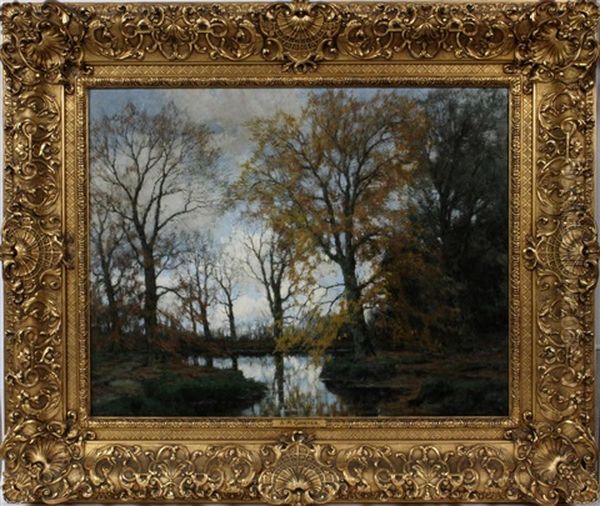
This international recognition extended further when he was made a member of the prestigious French Académie des Beaux-Arts. This was a rare distinction for a foreign artist, highlighting the high regard in which his work was held, particularly in France. His paintings also found an appreciative audience in the United States and other countries, frequently appearing in international exhibitions and entering numerous public and private collections worldwide.
Adding to his distinguished profile was his connection to the Dutch royal family. Gorter was acquainted with Queen Wilhelmina, herself an amateur painter. He reportedly served as her painting tutor or advisor for a period, indicating a level of trust and esteem that reached the highest levels of Dutch society. This connection further cemented his status as a leading artist of his time.
Representative Works
Gorter's oeuvre consists primarily of landscapes, and several works stand out as representative of his style and thematic concerns. While titles can sometimes vary or refer to similar compositions, key examples include:
Autumn Landscape: This title appears frequently, often associated with scenes featuring golden foliage, tranquil water, and sometimes grazing cattle or a solitary boat. These works, executed in both oil and watercolour, exemplify his mastery of seasonal atmosphere and his ability to convey the quiet beauty of the Dutch countryside in autumn. One such watercolour (47x61 cm) highlights his skill in this medium. Another variation might be Autumn Landscape with Grazing Cows or Autumn Landscape with Boat.
Forest River: Often depicting a calm river winding through a dense wood, these paintings showcase Gorter's skill in rendering trees, water reflections, and the interplay of light filtering through leaves. An oil painting titled Forest River (approx. 30x38 inches) fetched a significant price at auction, indicating the market value and appeal of these woodland scenes.
Shepherd in Autumn Landscape: Combining pastoral elements with his favoured autumnal setting, this subject (example size 27x33 inches) places a human figure within the vastness of nature, evoking a sense of harmony and timeless rural life, reminiscent of Barbizon themes but rendered with Gorter's characteristic touch.
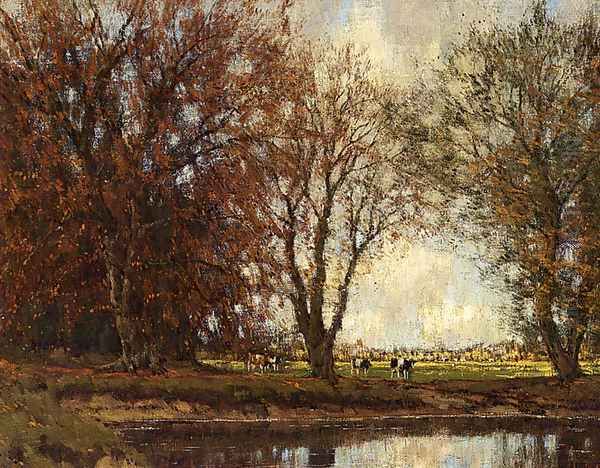
Vordense Beek: This work, depicting a scene near Vorden (likely featuring the stream 'Beek' means stream or brook) possibly with a distinctive tree (described as an oil palm tree in one source, though this seems geographically unlikely for the Netherlands and might be a mistranslation or refer to a specific type like Scots Pine often called 'palm' locally), is held by the Stedelijk Museum in Amsterdam. Its presence in a major museum collection confirms his importance. The dimensions (85.3 x 125.4 cm) suggest a significant, large-scale work.
Man in a Row Boat: This painting (approx. 15x20 inches) is notable for having won the Gold Medal at the Paris Salon in 1910. It likely depicted a serene water scene, focusing on the solitary figure and the reflections in the water, embodying the peaceful, contemplative mood often found in his work.
These works, and many others like them, consistently demonstrate Gorter's dedication to capturing the specific character of the Dutch landscape – its flatness, its waterways, its woods, and its gentle, diffused light – through a lens influenced by Romanticism and Impressionism.
Anecdotes and Personal Life
Beyond his formal career, glimpses into Gorter's personal life reveal a man deeply connected to the landscapes he painted. His decision to purchase land in the village of Denekamp, near his native Almelo, and build a house there named "Oude Preute," suggests a desire to remain rooted in the Twente region that so often inspired his art. This retreat likely served as both a home and a base for his artistic explorations of the surrounding countryside.
The influence of his mother, Geertruida ten Holtmeijer, the flower painter, remained a foundational aspect of his life story. Her early encouragement is consistently cited as crucial in nurturing his love for both nature and art, setting him on his path long before he entered the formal art world of Amsterdam.
The anecdote shared by his son, Hans Gorter – who himself pursued a career connected to nature as a museum director – about his father's specific technique for painting tree trunks offers a rare insight into the artist's working methods. It suggests a painter who was not merely following established formulas but was actively experimenting to achieve the desired effects, adding another layer to our understanding of his practice. These personal details paint a picture of an artist whose life and work were harmoniously intertwined with the natural world he depicted.
Legacy and Historical Evaluation
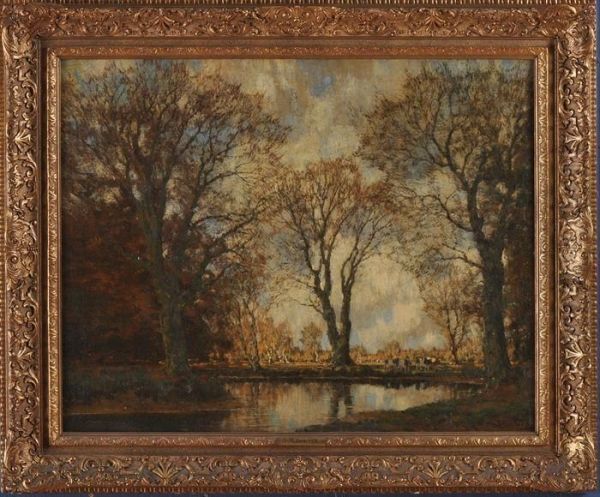
Arnold Marc Gorter occupies a respected place in the narrative of Dutch art at the turn of the twentieth century. He is primarily valued as a gifted and dedicated landscape painter who successfully carried forward the traditions of the Barbizon and Hague Schools, adapting them with a lighter palette and atmospheric sensitivity that aligned with Impressionist sensibilities, without fully dissolving form in the manner of the more radical French Impressionists.
Art critics and historians commend his technical skill, particularly his handling of light and colour, and his profound understanding and love of nature, which permeates his work. His paintings are often praised for their serene, poetic quality and their ability to capture the specific moods and atmospheres of the Dutch countryside, especially the wooded regions of the eastern Netherlands. He is seen as a master of the tranquil landscape, often focusing on idyllic, unindustrialized scenes.
His consistent success at the Paris Salon, the acquisition of his work by major institutions like the Louvre and the Stedelijk Museum, and his international recognition, including the rare honour of membership in the French Académie des Beaux-Arts, solidify his historical importance. While perhaps not an avant-garde innovator who drastically changed the course of art history, like Vincent van Gogh or Piet Mondrian who emerged from the same cultural milieu, Gorter represents the enduring strength and appeal of the Dutch landscape tradition.
His work continues to be appreciated by collectors and museum visitors for its aesthetic beauty and its evocative portrayal of nature. He remains a key figure for understanding the evolution of Dutch landscape painting in the period bridging the nineteenth and twentieth centuries, representing a lyrical, impressionistic interpretation of the national landscape that found widespread favour both at home and abroad.
Conclusion
Arnold Marc Gorter's legacy is that of a painter deeply devoted to the natural beauty of the Netherlands. Through his skillful brushwork, sensitive use of colour, and profound connection to the landscapes of his youth, he created a body of work that celebrates the tranquility and enduring charm of the Dutch countryside. Influenced by tradition yet possessing a distinct personal style, Gorter earned his place as a significant and internationally recognized master of landscape painting, whose works continue to resonate with viewers seeking solace and beauty in the depiction of nature.